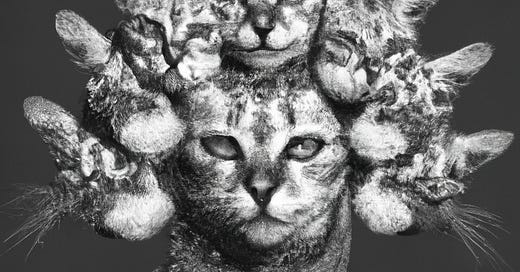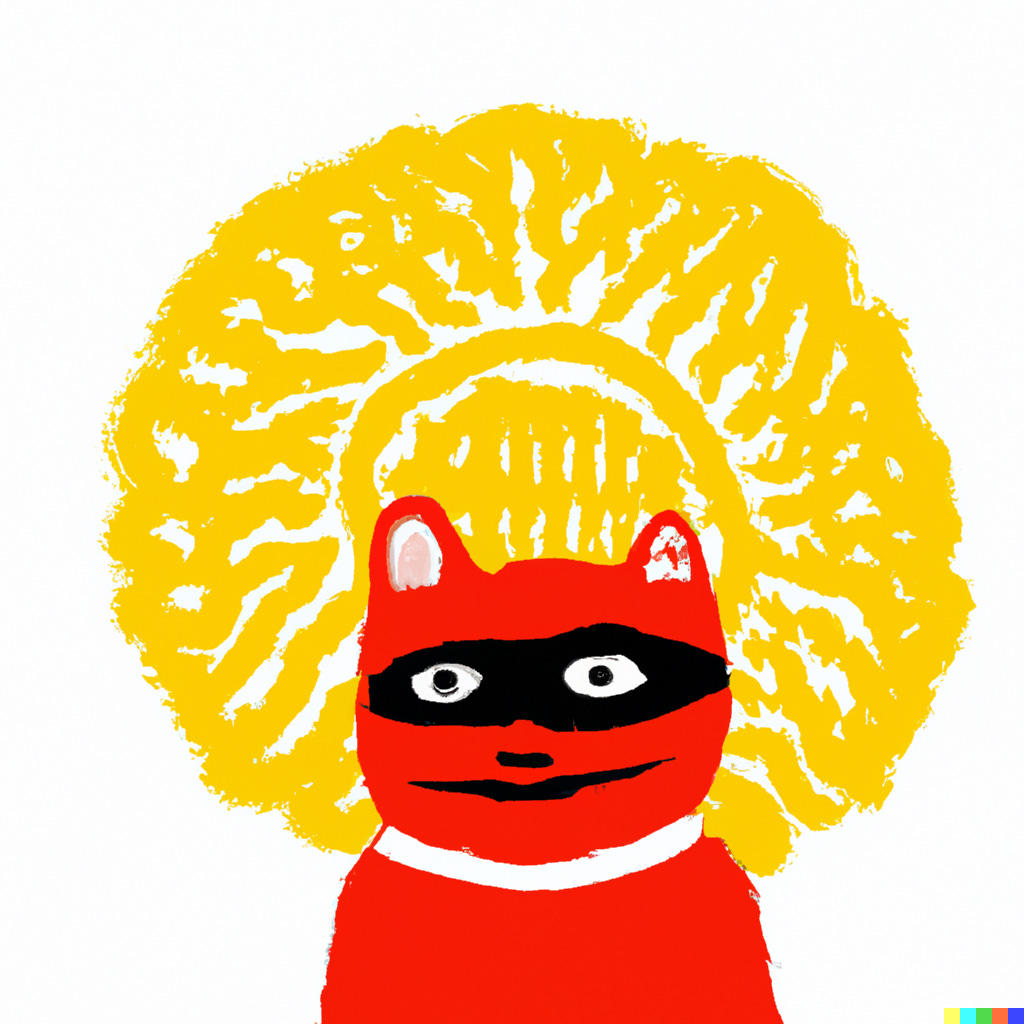Let's Give the People What They Want!
Our second simulation and a digression into the AI art boom
Included in this issue is the kick-off for our second simulation and an essay about the current artificial intelligence image generator boom. I’ve been interested in AI art for a while now, but things have been heating up lately, and it’s time to start talking about what it all means. It’s a different way of thinking about the financialization of art, but one that’s going to be very important to how we consume mass culture in the future. It’s a little off-topic for this newsletter, but since we are using AI in this simulation, I thought it would be good to digress for a bit.

SIMULATION #2: LET’S GIVE THE PEOPLE WHAT THEY WANT!
Okay, it’s time for another simulation, and this one is going to be easy peasy to participate in. I spent the last two newsletters writing about how some artists (Jeff Koons and Damien Hirst) created their careers by giving people exactly what they want: safe(ish) investment vehicles that increase and indicate the owner’s status. It’s supply and demand, baby! So I am going to do the same for you! We are going to figure out what you all want to see, and then I am going to use an artificial intelligence image generator to give it to you. Here’s how this will work:
1) You will need to leave a comment here or on my Instagram with a word or short phrase. This should be related to something about art that you love. What do you want to see? What do you like? What makes you sigh with adoration when you look at it? It can be a color, a style, a subject matter, a person - anything except an artist's name or the name of a piece. Rococo, blue, roses, Greek statues, satire, art deco, pumpkins, existential horror, Catherine the Great, etc. are fine. Artist names and artwork titles are not. I’ll get to why in a sec. It would be cool if you were serious about this and didn’t just add funny stuff, but maybe you really love funny stuff. I am not your mom and won’t judge. (Lies. I will.) As a group, we are going to define what we want. The more responses I get, the better this will be, but one idea per person, please.

2) I am going to take all those words and plug them into an image-generating artificial intelligence, probably DALLE*2. I will then create several images to post in the next newsletter, and you will get to vote on which one you think is the best. It may take me a bit of configuring text prompts to get some decent images, so I make no promises on how the exact process will go, but I will give you all the info when I show you the pictures.
3) I will then take that image and create a piece of digital art that will only be available for viewing by the people who voted. Now, you may be thinking, “I thought an AI-generated image already was a piece of digital art?” Ehhh, maybe? It’s definitely digital, but I am not sure it’s art. I have been taking the AI images I make and creating new works (books, prints, videos) out of them that have some sort of intentionality beyond shoving a bunch of keywords into a text box. You will receive a link and have access to this piece of art until my neocities website dies a natural death. (I thought about making NFTs, but it’s expensive, and I’m not really looking to get into that ecosystem.)
Now, why am I asking you not to list any artist names or artwork titles? One of the things being talked about right now is the images being used to teach the AIs how to do their thing. The tech companies use data scraped off the internet, and artists are being included in the learning data sets who don’t want to be there. I will address this in the second part of the newsletter, but the point of this exercise is not to appropriate anyone’s style. It’s to see what the AI can create when given looser parameters.
So, leave a comment and then vote when the next newsletter comes out to get access to a (hopefully) cool piece of digital art.
AI IMAGE GENERATORS ARE GAME-CHANGING, AND THAT MAY NOT BE GREAT FOR EVERYONE.
I have been using AI to make art since last spring when I used a predictive text generator created by OpenAI, GPT-3, to write a small book called Nine Mildly Depressing Poems about Art, Copies, Simulations, and the Sadness of Life. I then started using image generators like DALLE*2, also by OpenAI, and Dream by Wombo. This was before a lot of AI art programs were available to or known about by the general public, and it was super fun to just mess around. Since these programs are taught using data from the internet, I started thinking of AI as part of our collective unconscious, and have been making a series of works about that called Ghost Machine. But then something interesting happened; the technology did not drastically improve, but the amounts of data being fed to these programs increased by A LOT, and the AIs started getting better. Companies started opening them up to the public, and now millions of AI-generated images are being created by all sorts of people. But there are questions! And ethical issues! And like all new technologies, this stuff got released before all that squishy stuff was worked out. I view AI with hope; it doesn’t have to only be used for surveillance and serving up advertising. But if we don’t imagine something better, we will probably just end up with what tech bros and businesses folks think will make them the most money. The people who are pushing back on this technology have legit points, and I thought I would highlight some of them here. I am simplifying things a bit, so I have included some links to folks who have gone into more depth on the individual issues.
Is it even art? I don’t know the answer to this. I am not sure that the images created by AI are art, just like I am not sure that all of Damien Hirst’s spot paintings are. They both lack a certain intentionality that I think “fine” art needs. But there is a lot of mediocre art in this world, and maybe these both just fit into that category. I am not sure that text prompts are enough to make AI output more than just an image. BUT, I think you can take those images and combine them or give them new context and create something with deeper meaning.
An A.I.-Generated Picture Won an Art Prize. Artists Aren’t Happy.
Is it stealing? This is actually two issues. One is that working artists who have images on the internet are included in the learning datasets, and some believe images created using these datasets constitute derivative works and they should be compensated or removed. I’m not really sure about this one. All artists learn from other artists. And copy. And steal. Art is always in conversation with other art. I do however heavily sympathize with the other issue - that it is too easy to rip off someone else’s style. From what I understand, If I tell DALLE*2 to make me some Van Gogh sunflowers, it is going to give me some sunflowers in Van Gogh’s style, not a copy of one of his existing paintings, and that doesn’t feel like a big deal. But if I am a living artist and everybody starts making works that can be mistaken for mine, that might hurt my ability to make a living and possibly my reputation.
The Alt-Right Manipulated My Comic. Then A.I. Claimed It.
A.I. Is Exploding the Illustration World. Here’s How Artists Are Racing to Catch Up
Artists are gonna lose money. Illustrators are concerned about people using AI to create images instead of paying artists. If I just need a quick image to put into my newsletter, I might just create something via AI instead of hiring someone.
"Art is dead Dude" - the rise of the AI artists stirs debate
Misinformation is gonna be a problem. One of the interesting things about AIs is that they hallucinate. Text generators like ChatGPT aren’t regurgitating facts, they are predicting the next word in the conversation. And sometimes that prediction is bad. Also, pulling your learning dataset from the internet means you are gonna get what’s on the internet - a lot of which is awful. So without safeguards, it’s going to be easy to spread misinformation. (Even more than it already is.) Image generators are gonna make deepfakes a piece of cake to make. We don’t teach much image literacy outside of art school, and AI is going to make it even easier to create visual disinformation that can mislead or ruin lives. (Think revenge porn, conspiracy theories, and political machinations.)
AI image generation tech can now create life-wrecking deepfakes with ease
AI Platforms like ChatGPT Are Easy to Use but Also Potentially Dangerous
The New Chatbots Could Change the World. Can You Trust Them?
Who is making money from this? The tech companies and not always in the way you think; it’s not just about people paying to make images and have funny poems written by a machine. AI is already being used in fields where people want to analyze large amounts of data and make predictions (think stock analysis and law enforcement), and that is definitely going to be applied to the art and entertainment worlds. Art critic Ben Davis has a really good essay on AI in his new book, Art in the After-Culture: Capitalist Crisis & Cultural Strategy, where he writes:
“In a situation of intensive corporate control over the attention space, the dominant application of AI for culture is most likely refining ways to make our entertainment feeds feel more addictive - encouraging us to graze on the “new enough” permutations of things we like while companies come up with new and better ways to anticipate our desires in order to feed us more things…”
This isn’t about artists finding a balance between their ideas and what it takes to get something made by the large entertainment conglomerates; it’s about giving people what they want whenever they want it. It doesn’t have to be good, it just needs to go down easy. Ugh. I think it’s possible to create interesting art with artificial intelligence, but we’re gonna have to fight for it. RISE UP AND MAKE SOMETHING COOL TO SHARE! GO LOOK AT THINGS THAT ARE AN EXPRESSION OF SOMEONE ELSE’S IDEAS! DON’T LET THE BORING TECHNOCRATS WIN!






Texture and lines
starling murmurations!